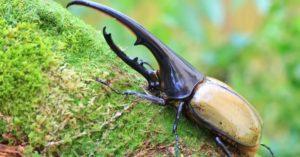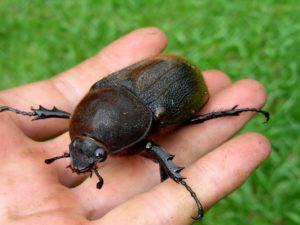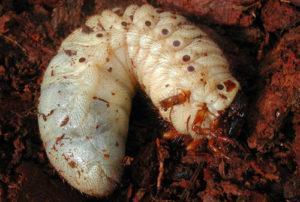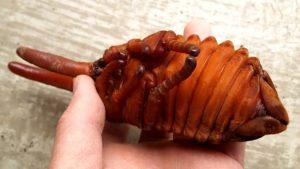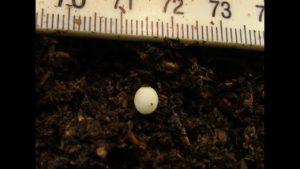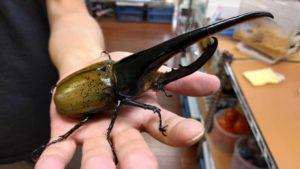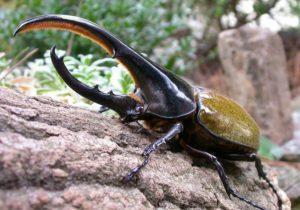Hercules Beetle (Dynastes hercules)
The Hercules beetle is a scarab beetle found in parts of North and South America. They are among the largest beetles and one of the largest flying insects in the world. Swedish zoologist Carl Linnaeus first described this species in 1758.
Scientific Classification
- Family: Scarabaeidae
- Genus: Dynastes
- Scientific name: Dynastes hercules
Physical Description and Identification
Adult
Size:5 – 8.5 cm long, 2.9 – 4.2 cm wide
Color:The bodies of the male beetles are entirely black, with olive-green elytra. The elytra can change color according to humidity levels, becoming black with rising humidity levels. There are small black spots on the wing covers.
While female beetles generally have fully black elytrae, but the last 1/4th of their wing covers sometimes resemble the male.
Other Characteristic Features:The males have two horns, which are the distinguishing features of these beetles. One of these horns is on the head, while a much larger one can be seen emerging from the prothorax.
Larva
Their bodies are yellow, with a black head. They can grow up to 11 cm and weigh up to 100 g. It can stay in this stage for up to 2 years and go through 3 instars. The first instar lasts for 50 days, the second around 56, and the third for 450 days.
Pupa
The pupal stage lasts for 32 days.
Egg
Eggs have an incubation period that lasts for 27.7 days. Females lay up to 100 eggs in their lifetime on dead wood.
Quick Facts
| Lifespan | 3-6 months |
| Distribution | From southern Mexico to parts of South America including, Brazil, Columbia, Ecuador, and Peru |
| Habitat | Montane and lowland rainforests |
| Seasons active | Midsummer to early winter |
| Host plants | Rotting wood |
| Diet of adults | Fresh and rotting fruit including apples, grapes, peaches, and pears |
Identifying the Damage Caused by Them
They primarily eat rotten wood and fruit, so they do not cause too much damage. The adults may attack fruit at times.
Did You Know
- Hercules beetles can carry 100 times their mass, after which they are incapable of movement.
Image Source: kylonpowell.com, entnemdept.ufl.edu, a-z-animals.com, scontent.fccu4-2.fna.fbcdn.net, v.w-x.co, i.ytimg.com, cdn-japantimes.com, static.wikia.nocookie.net, 1.bp.blogspot.com
The Hercules beetle is a scarab beetle found in parts of North and South America. They are among the largest beetles and one of the largest flying insects in the world. Swedish zoologist Carl Linnaeus first described this species in 1758.
Physical Description and Identification
Adult
Size:5 – 8.5 cm long, 2.9 – 4.2 cm wide
Color:The bodies of the male beetles are entirely black, with olive-green elytra. The elytra can change color according to humidity levels, becoming black with rising humidity levels. There are small black spots on the wing covers.
While female beetles generally have fully black elytrae, but the last 1/4th of their wing covers sometimes resemble the male.
Other Characteristic Features:The males have two horns, which are the distinguishing features of these beetles. One of these horns is on the head, while a much larger one can be seen emerging from the prothorax.
Larva
Their bodies are yellow, with a black head. They can grow up to 11 cm and weigh up to 100 g. It can stay in this stage for up to 2 years and go through 3 instars. The first instar lasts for 50 days, the second around 56, and the third for 450 days.
Pupa
The pupal stage lasts for 32 days.
Egg
Eggs have an incubation period that lasts for 27.7 days. Females lay up to 100 eggs in their lifetime on dead wood.
Quick Facts
| Lifespan | 3-6 months |
| Distribution | From southern Mexico to parts of South America including, Brazil, Columbia, Ecuador, and Peru |
| Habitat | Montane and lowland rainforests |
| Seasons active | Midsummer to early winter |
| Host plants | Rotting wood |
| Diet of adults | Fresh and rotting fruit including apples, grapes, peaches, and pears |
Identifying the Damage Caused by Them
They primarily eat rotten wood and fruit, so they do not cause too much damage. The adults may attack fruit at times.
Did You Know
- Hercules beetles can carry 100 times their mass, after which they are incapable of movement.
Image Source: kylonpowell.com, entnemdept.ufl.edu, a-z-animals.com, scontent.fccu4-2.fna.fbcdn.net, v.w-x.co, i.ytimg.com, cdn-japantimes.com, static.wikia.nocookie.net, 1.bp.blogspot.com




